Wimbledon Betting Offers 2024
 The Championships at Wimbledon (as it is formally known) is the third of the four tennis grand slam tournaments of the season and is also the oldest, having first taken place in 1877. After the Australian Open moved to a hardcourt style in 1988 Wimbledon is now the only major tournament still played on grass.
The Championships at Wimbledon (as it is formally known) is the third of the four tennis grand slam tournaments of the season and is also the oldest, having first taken place in 1877. After the Australian Open moved to a hardcourt style in 1988 Wimbledon is now the only major tournament still played on grass.
Wimbledon is seen as the pinnacle of style and taste for most tennis fans and not just because of the strawberries and cream. Grass is the fastest of all tennis courts with its slippery surface meaning only the quickest players can keep up. The ball also has a lower and more unpredictable bounce due to the soil and uneven grass surface.
Wimbledon traditionally has no sponsor but can still offer over £45 Million in prize money, nothing to be sniffed at. All matches are shown by the BBC and with so much interest there are plenty of great Wimbledon betting promotions for both new and existing customers around. On this page you can also find details of the best deals along with schedules, previous winners, history and more.
Wimbledon Betting Offers for 2024
This event has not started yet, please check back nearer the time. For other offers see our main loyalty page.
Wimbledon Schedule 2024
| Date | Day | Round / Match |
|---|---|---|
| 1st July | Monday | First Round |
| 2nd July | Tuesday | First Round |
| 3rd July | Wednesday | Second Round |
| 4th July | Thursday | Second Round |
| 5th July | Friday | Third Round |
| 6th July | Saturday | Third Round |
| 7th July | Sunday | Fourth Round |
| 8th July | Monday | Fourth Round |
| 9th July | Tuesday | Quarter Finals |
| 10th July | Wednesday | Quarter Finals |
| 11th July | Thursday | Semi Finals |
| 12th July | Friday | Semi Finals |
| 13th July | Saturday | Ladies Final |
| 14th July | Sunday | Men’s Final |
* Other games may be scheduled on this day if delayed due to weather. Rest day to be removed form 2022 onwards.
Grounds open at 10:30, play begins at midday on Courts 2-19 and 1pm on Centre Court (2pm for the final). In the second week play begins at 11am on the outer courts for junior matches.
Wimbledon Format
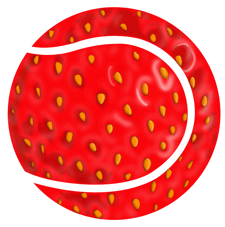 Wimbledon, like all grand slam tournaments, follows a simple knockout format from the first round to the final. The Championships are played over 14 days starting on a Monday and with a rest day on the first Sunday. On three occasions play has been allowed on the Sunday to clear fixture backlog due to weather, this happened in 1991, 1997 and 2004. The middle Sunday break was scrapped from 2022 onwards.
Wimbledon, like all grand slam tournaments, follows a simple knockout format from the first round to the final. The Championships are played over 14 days starting on a Monday and with a rest day on the first Sunday. On three occasions play has been allowed on the Sunday to clear fixture backlog due to weather, this happened in 1991, 1997 and 2004. The middle Sunday break was scrapped from 2022 onwards.
Organisers have announced the rest day would be scrapped from 2022 onwards, this is to prevent fixture build up and ease pressure on ‘Manic Monday’, the day that follows the rest day and is the busiest day of the week. The rest day was created mainly to give groundmen opportunity to tend to the courts, however, technological advances in ground keeping now means this is no longer needed.
Both the male and female draw contains 128 players. The majority of these players are selected based on their ATP and WTA rankings. There are 104 direct male entries, 108 direct female entries, 8 wildcards for both sexes and the rest made up of qualifiers.
Wildcards are selected by the organising committee. There is no set formula but this is based on both previous performance and players likely to peak public interest. The last wildcard to win Wimbledon was Goran Ivanisevic back in 2001.
Players that neither have sufficient rankings or receive a wildcard can enter into qualifying rounds. Qualifying is held in the week prior to the Championships in Roehampton with three rounds for singles and a single round for doubles, no qualifying is held for mixed doubles. John McEnroe still holds the record for the furthest progress of a qualifier, reaching the semi-finals in 1977. All Junior players are admitted by their rankings, by recommendation by their own national associations and through qualification.
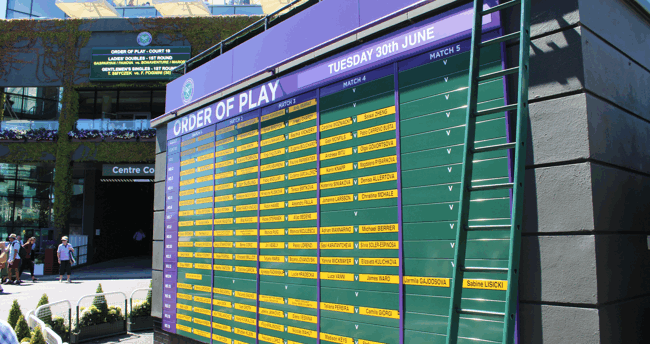
The organising committee seeds the top 32 male and female singles players and the top 16 doubles teams. Seeding is based on ATP/WTA rankings as well as previous performance at Wimbledon and on grass courts. The system is ATP points + 100% points earned on grass in the last year + 75% of the points from the best grass performance in the last year. Seeded players are entered into the draw in an order that will keep them apart until the third round (Last 32) at least. This ensures the top players are more likely to make it to later rounds.
Only Goran Ivanisevic as a wildcard (2001) and Boris Becker (1985) have won the men’s singles as an unseeded player and as yet no unseeded woman has won Wimbledon.
New Final Set Tie-Breaks At Wimbledon From 2019
 Final set tie-breaks were introduced at Wimbledon from 2019. Unlike the US Open the tie-break will not begin immediately if the set is tied 6-6, but instead games will continue in the hope that a player will win by two clear games, if there is no overall winner by the time the match gets to 12 games all (12-12) then a tie-break will ensue.
Final set tie-breaks were introduced at Wimbledon from 2019. Unlike the US Open the tie-break will not begin immediately if the set is tied 6-6, but instead games will continue in the hope that a player will win by two clear games, if there is no overall winner by the time the match gets to 12 games all (12-12) then a tie-break will ensue.
The idea is to strike a balance by giving players a chance to win through game advantage, but then introducing the tie-break at a reasonable point to prevent matches and final sets going on for hours. This followed the 26-24 victory by Kevin Anderson in the final set between against John Isner in 2018 that went on for over nearly 3 hours. The Wimbledon match length record was set back in 2010 in a match in which John Isner also played, this time he won the match 70-68 against France’s Nicolas Mahut, which took just over 11 hours.
The new system was in fact used in its very first year, 2019, when Novak Djokovic beat Roger Federer in an epic final set tie break with both tied on 12-12. This was already the longest Wimbledon final in history at 4 hours 57 minutes, you can only imagine how long it might have gone on if the new rule were not in place.
No More Rest Day From 2022
 From 2022 onwards Wimbledon will move to a full 14-day event with no traditional rest day on the middle Sunday. The rest day has been a fixture of the Championships since it started in 1877 and is seen as part of the heritage and tradition. The middle Sunday has only been used four times in history prior to 2022, all coming within a 25 year period in the modern era (1991, 1997, 2004 and 2016). On each occasion the rest day was used due to prior rain delays and have all been unrestricted seating days with cheap tickets, often called ‘People’s Sunday’.
From 2022 onwards Wimbledon will move to a full 14-day event with no traditional rest day on the middle Sunday. The rest day has been a fixture of the Championships since it started in 1877 and is seen as part of the heritage and tradition. The middle Sunday has only been used four times in history prior to 2022, all coming within a 25 year period in the modern era (1991, 1997, 2004 and 2016). On each occasion the rest day was used due to prior rain delays and have all been unrestricted seating days with cheap tickets, often called ‘People’s Sunday’.
While many sceptics have complained about this and suggested that the day is being removed so the event can earn more revenue, in reality it is more to do with improvements in ground keeping technology. The middle Sunday was largely left alone to allow groundsmen chance to tend to the numerous courts at Wimbledon but in modern times improvements in the grass itself and the way it is maintained makes the rest day now defunct from that perspective. The Championships now also hosts far more individual matches than it did in the early days, hence why all the rest days used for play have come since 1991.
The extra day will also remove pressure from so called ‘Manic Monday’, the day following the traditional Sunday rest days that sees the most matches of the entire Championship. Fourth round matches will now be played over Sunday into Monday. The removal of the rest day also coincides with the centenary year for Centre Court.
Statistics & Previous Winners
| Statistic | Player | Country | Number | Year(s) |
|---|---|---|---|---|
| Men’s Titles | Roger Federer | Switzerland | 8 | 2003-2007, 2009, 2012, 2017 |
| Men’s Consecutive Titles | Bjorn Borg & Roger Federer | Sweden / Switzerland | 5 | 1976-80 (Borg), 2003-07 (Federer) |
| Women’s Titles | Martina Navratilova | Czech | 9 | 1978-79, 1982-87, 1990 |
| Women’s Consecutive Titles | Martina Navratilova | Czech | 5 | 1982-87 |
| Men’s Doubles Titles | Todd Woodbridge | Australia | 9 | 1993-97, 2000, 2002-04 |
| Men’s Doubles Consecutive Titles | Todd & Mark Woodbridge | Australia | 5 | 1993-97 |
| Women’s Doubles Titles | Martina Navratilova | Czech | 7 | 1976, 1979, 1981-84, 1986 |
| Women’s Doubles Consecutive Titles | Martina Navratilova / Pam Shriver | Czech / USA | 4 | 1981-84 |
| Mixed Doubles Titles | Martina Navratilova | Czech | 4 | 1985, 1993, 1995, 2003 |
| Men’s Youngest Winner | Boris Becker | Germany | 17yrs 227d | 1985 |
| Women’s Youngest Winner | Lottie Dod | Great Britain | 15yrs 285d | 1987 |
| Men’s Oldest Winner | Roger Federer | Switzerland | 35y 11m | 2017 |
| Women’s Oldest Winner | Serena Williams | USA | 33yrs 289d | 2015 |
| Last Men’s Winner | Carlos Alcaraz | Spain | – | 2023 |
| Last Women’s Winner | Markéta Vondroušová | Republic | – | 2023 |
| Last Men’s Doubles Winner | Wesley Koolhof / Neal Skupski | Netherlands / UK | – | 2023 |
| Last Women’s Doubles Winner | Hsieh Su-wei / Barbora Strýcová | Taipei / Czech Republic | – | 2023 |
| Last Mixed Doubles Winner | Mate Pavić / Lyudmyla Kichenok | Croatia / Ukraine | – | 2023 |
All records from the professional Open Era, 1968 onwards.
About The Championships, Wimbledon
History of Lawn Tennis and the All England Club
 The All England Club was founded as a private member’s club in 1868 on Worple Road in Wimbledon, London. Major Walter Clopton Wingfield is credited as a pioneer of the game devising the game in 1875 and in 1876 it was added to the list of games played at the club.
The All England Club was founded as a private member’s club in 1868 on Worple Road in Wimbledon, London. Major Walter Clopton Wingfield is credited as a pioneer of the game devising the game in 1875 and in 1876 it was added to the list of games played at the club.
The following year lawn tennis was added to the name of the club to give it its full name, the All England Lawn Tennis and Croquet Club, and a new list of rules and laws drawn up.
History of the Wimbledon
 In 1877 the first Wimbledon Championship was held. The event was male only with 22 entrants. The championship was won by Spencer Gore, a British ex-cricketer who had played for Surrey, he was raised in Wimbledon within a mile of the All England Club. Around 200 people paid one shilling each to watch the first final.
In 1877 the first Wimbledon Championship was held. The event was male only with 22 entrants. The championship was won by Spencer Gore, a British ex-cricketer who had played for Surrey, he was raised in Wimbledon within a mile of the All England Club. Around 200 people paid one shilling each to watch the first final.
There were several tennis ‘lawns’ set around the main court in the centre, known to this day as centre court. By 1882 the All England Club was almost exclusively for tennis with little croquet being played, despite dropping the name croquet from the club title it was restored in 1899 for sentimental reasons and is still in place today.
By 1884 Ladies tennis and men’s doubles were been added to the Championships, ladies doubles and mixed doubles were added later in 1913. Up until 1922 the reigning champion received a bye straight to the final.
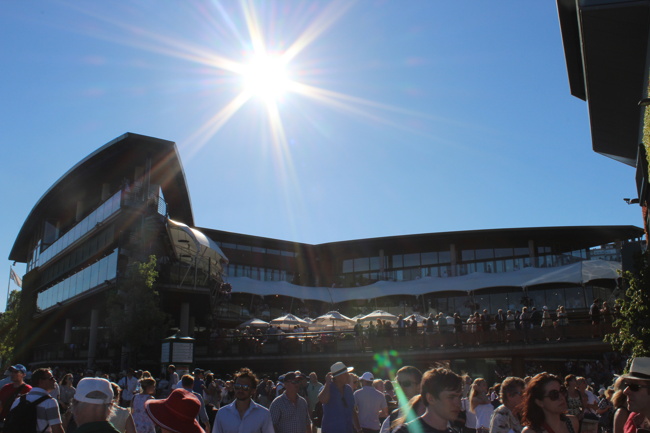
The All England Club moved sites in 1922 to the new site on Church Road, the court layout was kept the same based around the centre court. The event, like the French Open, remained an amateur game with professionals banned until the Open era began in 1968.
Wimbledon was one of the first televised tennis event, first aired in 1937, the year after Fred Perry became the last Brit to win until Andy Murray in 2013.
These days Wimbledon is the worlds leading grass tennis tournament and for most people the premier tennis event overall. This has been helped through modernisation in the mid 1990’s that culminated in the building of the new Court 1 in Aorangi Park (also colloquially known as Henman Hill and Murray Mound) with a nearly 12,000 seating capacity.
Other courts have also been added, including a 4000 seater Court 2 and a 2000 seater court 3 as well as state of the art facilities for player and press in the Millennium Building.
Weather, Centre Court & No. 1 Court
Wimbledon is the most Northern of all tennis majors and based in Britain is susceptible to changing weather even in July. To ensure top tennis matches could be played at all times a new retractable roof was added to centre court in 2009, first used in a 4th round ladies singles match between Dinara Safina and Amélie Mauresmo. Andy Murray and Stan Wawrinka played the first match from start to finish under the new roof.
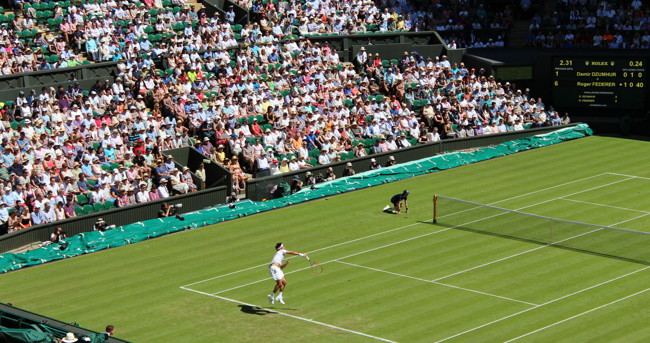
The artificial lighting available under the new roof also lead to the latest match in history between Andy Murray and Marcos Baghdatis in the 2012 3rd round. The game won by Murray ended at 11:02pm. The centre court roof takes around 20 minutes to close.
For the 2019 Championships No. 1 Court was given a new retractable roof also. This means more matches will be played in bad weather reducing the effect on the timetable whilst also ensuring spectators, at the grounds and on TV, will have more to watch when it rains.
Prize Money
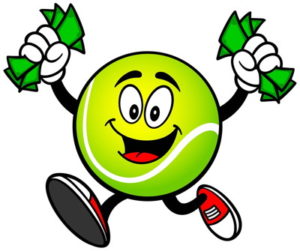 The men’s champion receives a half meter high silver trophy first awarded in 1887. The women’s champions receives a silver salver known as the ‘Rosewater Dish’, again around half a meter wide. Doubles winners receive silver cups and the runners up get silver plates.
The men’s champion receives a half meter high silver trophy first awarded in 1887. The women’s champions receives a silver salver known as the ‘Rosewater Dish’, again around half a meter wide. Doubles winners receive silver cups and the runners up get silver plates.
The first prize money was only awarded in 1968 when the event became a professional tournament in the open era. Prior to 2007 larger prizes were given to the men but this was changed to give equal payouts to both sexes.
The prize for the 1968 Wimbledon winner was just £2,000 for men and £750 for women. In 2019 the prize pot hit £38 Million in total with the winners picking up £2.35 Million each. This increase is partially driven by the reduced competitiveness of the British Pound following Brexit, with organisers feeling they must increase the winnings to be competitive with other grand slams.
The 2021 prize fund actually shrunk by 7.9% to £35M in light of the issues caused by the corona virus pandemic. For 2022, however, the prize fund reached new levels again with £40.35M in the total purse and £2 Million each for the men’s and women’s Champion. In 2023 the fund increased to £44.7M with 2.35M for the men’s and women’s singles winners, a nearly 11% increase on the previous year.
Wimbledon Courts

Wimbledon is one of the most famous tennis venues in the world, considered by many to be the home of the sport. From Henman Hill, more recently called Murray Mount, through to the snakes of people waiting around the Wimbledon area for ticket returns, it’s an iconic location that serves up memory after memory for the adoring public watching both in the venue and at home.
Here’s a look at the different areas of Wimbledon:
Centre Court
 The place that all tennis players dream of being able to play a match, Centre Court incorporates the All England Lawn Tennis and Croquet Club’s clubhouse as well as the Royal Box. It took its name originally from the fact that it was located in the centre of all of the other courts, in spite of the fact that the 12 courts used for the original Wimbledon in 1877 were arranged in a 3×4 grid and had no centre.
The place that all tennis players dream of being able to play a match, Centre Court incorporates the All England Lawn Tennis and Croquet Club’s clubhouse as well as the Royal Box. It took its name originally from the fact that it was located in the centre of all of the other courts, in spite of the fact that the 12 courts used for the original Wimbledon in 1877 were arranged in a 3×4 grid and had no centre.
The first time that Centre Court actually stood in the centre was in 1881 when the two courts in the middle were combined to make one. That was when the club was based off Worple Road, but the name stuck when the All England club moved to its current location at Church Road in Wimbledon in 1922. Even then the court wasn’t in the middle, failing to be so until 1980 when four more courts were added to the club’s facilities. Centre Court celebrated its centenary in 2022.
The biggest changes to Centre Court in the modern era came about in 2009 when the capacity was expanded to 14,979 and a new retractable roof was added. That also led to new media facilities being built, as well as new scoreboards being installed. The roof can be closed within 10 minutes, within additional half an hour or so needed to allow the air conditioning system to kick-in. Lines from the Rudyard Kipling poem ‘If-‘ are inscribed above the entryway to Centre Court.
No. 1 Court
 The current version of No. 1 Court opened in 1997, replacing the former court of the same name that had opened its doors for the first time in 1924. That had room for just over 3,000 spectators, whilst the current iteration can welcome 11,360 people through its doors.
The current version of No. 1 Court opened in 1997, replacing the former court of the same name that had opened its doors for the first time in 1924. That had room for just over 3,000 spectators, whilst the current iteration can welcome 11,360 people through its doors.
It first opened on the 23rd of June 1997 for a match between Tim Henman and Daniel Nestor. In 2013 it was confirmed by the All England Club that they would be building a replica of Centre Court’s retractable roof, which would be in place ahead of the 2019 Wimbledon Championships.
No. 2 Court
The original No. 2 Court was known as the Graveyard of Champions, but it was renumbered to become the No. 3 Court when a new No. 2 Court was built in 2009 on the site of the old No. 13 Court.
It has a capacity of 4,000.
No. 3 Court
Just to add a touch of confusion to proceedings, the old No. 2 Court was renumbered as No. 3 Court in 2009 before it was demolished. The demolition was done in order to make room for new No. 3 and No. 4 Courts, which opened ahead of the 2011 Championship.
No. 3 Court in its new form can welcome 2,000 spectators.
The Rest Of The All England Club

There are 18 grass courts in use for tournaments at the time of writing, as well as 8 American clay courts, 5 indoor courts and 2 acrylic courts that aren’t used for the Wimbledon Championship. Aorangi Park boasts 22 grass courts that are used for practice ahead of The Championships.
It’s a common misconception that the so-called Henman Hill / Murray Mount is outside of the club when in actual fact it is inside and can only be used to watch big screens by people that already have tickets. It is located at the part of the club known as Aorangi Park, where No 1. Court can be found.
Since 1995 the grass at Wimbledon has been cut to 8 millimetres and it has been 100% perennial ryegrass since 2001. In 2018 the All England Club agreed but Wimbledon Park Golf Club for a fee believed to be £65 million, with the aim being to expand the Lawn Tennis Club.
Court Types and Characteristics, Clay vs Hard vs Grass
| Court | Characteristics | Player Types Who Do Well | Top Player |
|---|---|---|---|
| Grass | Grass courts are fast, with dew and water residue causing the balls to skim across the surface and ask questions of the players | Serve & volley players will always stand a good chance of winning when playing on grass, predominantly because the ball doesn’t bounce as hit as on the other surfaces | Roger Federer |
| Clay | Clay courts are the slowest of the three, with the ball bouncing higher than grass but lower than on hard courts | Players that have the ability to concentrate on long rallies do well on hard courts, with those that tend to play from the baseline or beyond excelling | Rafael Nadal |
| Hard | Hard courts are the middle ground of the other two when it comes to the speed of the game. The court is the firmest of the lot, so the bounce can often be quite challenging to deal with | Rallies on hard courts tend to be much longer than on either of the other surfaces, so a player with the mental fortitude to stay focussed will do best | Serena Williams |
A player who knows how to win on clay won’t automatically be good at playing on grass or hard courts, whilst one that knows how to win on a hard court can’t necessarily translate that to being able to win on either of the others. It might seem odd, but the different court types ask something entirely different of the players and require a separate set of skills from each other.
Of course to some extent players need to have certain characteristics, with the game played on each court type still tennis Yet they’ll have to adapt their game if they want to be successful, as denoted by the following brief look at how each court type works:
Each court type asks something different of the players, with the following being a more in-depth look at what to expect from them:
Grass Courts

Wimbledon is the only Grand Slam to be played on tennis, but it is seen by many as being the quintessential example of the sport in England. It’s reminiscent of summer days, strawberries and cream and Prosecco being drunk on the lawn. From a tennis point of view, it’s about fast-paced games that require speed of thought as well as body.
Grass courts tend to be slippery thanks to the moisture that rests on the top of the surface, which allows the ball to skid away in a much more slick manner than on wither of the other surface types. The grass also takes the energy out of the ball, resulting in a lower bounce that means that players need to put their own power behind the ball.
Serve and volley is a key strategy in grass court tennis because it removes the need to enter into groundstrokes and win rallies. Big servers often do well on grass court too because the lack of bounce often makes life difficult for the returners. The season is shorter than in either clay or hard court, so it’s more difficult for players to adapt to the style and they tend to want to play in tournaments before hitting Wimbledon to get themselves used to the way the ball bounces.
For men the biggest pre-Wimbledon tournament is the Championship at Queen’s Club, whilst for women it’s the Eastbourne International. If you’re hoping for an idea of who will do well in the upcoming grass court Grand Slam then they are two of the ones to watch.
Clay Courts
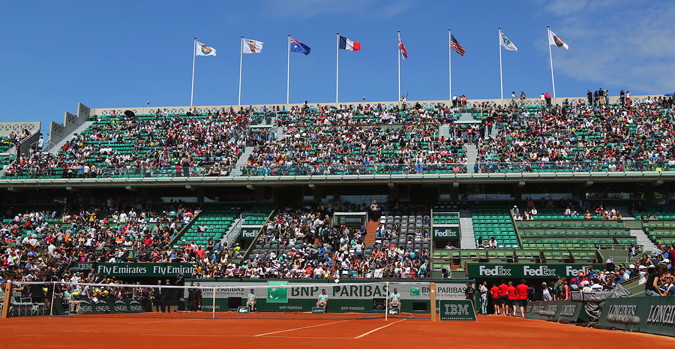
Class courts aren’t actually made out of clay itself, instead being made up of crushed brick and other composite materials. The top layer is usually a very finely crushed set of brick particles, spread over the top and packed to make it dense. It’s why you can see the marks of the ball and the players’ feet as they run around the court.
Rafa Nadal is widely considered to be one of the best-ever players on clay, principally because of the number of topspin shots that he hits that make life incredibly difficult for his opponents. He tenacity also serves him well on clay, chasing down every point and using the higher bounce that the surface offers when compared to grass to win points.
Clay courts require fitness and stamina of the players that play on them, being a much slower surface than grass. The French Open is the only Grand Slam played on clay, preceded by the Italian Open, which is the final warm-up event before it gets underway.
Hard Courts

Concrete or asphalt are the main surfaces that are used for hard courts, with the surface then being topped by an artificial material that gives it a bit more bounce and allows for the drawing of the lines etc. Plexicushion, GreenSet and DecoTurf are examples of companies that make hard court surface toppers.
Two Grand Slams feature a hard court surface, which are the Australian Open and the US Open. That means that half of the four Grand Slam events are played on hard courts, which is reflective of the fact that it’s by far the most popular surface type around the world. It offers very little absorption of the ball’s energy, leading to a high bounce and long rallies.
Roger Federer
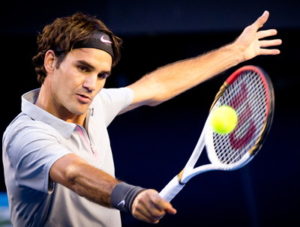 Just as it’s impossible to talk about clay courts without looking at the career of Rafa Nadal and you can’t mention hard courts without looking at the success of Serena Williams, so too is it important to discuss the career of Roger Federer when thinking about grass courts. The Swiss player who picked up a record 8 Wimbledon titles between 2003 and 2017.
Just as it’s impossible to talk about clay courts without looking at the career of Rafa Nadal and you can’t mention hard courts without looking at the success of Serena Williams, so too is it important to discuss the career of Roger Federer when thinking about grass courts. The Swiss player who picked up a record 8 Wimbledon titles between 2003 and 2017.
Born in the municipality of Bottmingen in Switzerland on the 8th of August 1981, the right-handed tennis maestro’s love affair with Wimbledon began in 1998 when he won the Boys’ Single final at the expensive of Irakli Labadze, winning the Doubles final at the same time. He also reached the final of the US Open in the same year, but lost out to David Nalbandian. He was named as the ITF Junior World Champion at the end of the year, having become the World Junior Number 1.
He reached his first senior final when he lost to countryman Marc Rosset in 2000, winning the Hopman Cup the following year playing with Martina Hingis. That was also the year that he won his first singles championship when he beat Julien Boutter in the final of the Milan Indoor Tournament. It was a good year for the Swiss, making the quarter-finals of the French Open, which was the furthest stage he’d reached of a Grand Slam.
Federer’s first real experience of the grass courts of Wimbledon as a professional came in 2001 when he defeated defending champion Pete Sampras over five sets to reach the quarter-finals. Once again it was the furthest stage of Grand Slam he could reach, being knocked out by Tim Henman on a tie-breaker in the fourth set. It gave him a taste for the tournament, however, and he returned in 2003 to beat Mark Philippoussis in the final to win the trophy for the first time.
2004 saw Federer defend his Wimbledon crown at the same time as beating Marat Safin in the Australian Open and Lleyton Hewitt in the US open to win three of the four Grand Slam tournaments. Never one for sentiment, the Swiss player won his third successive Wimbledon time in 2005 and also beat Andre Agassi in the American’s last ever major final at the US Open. The year after he took things to another level, winning 12 singles titles and reaching the final of all but one of the 17 tournaments he entered.
Such is Federer’s longevity in the sport, he has enjoyed numerous rivalries during his career. The most obvious ones have been against Rafael Nadal, Novak Djokovic and Andy Murray, but he also battled well with Andy Roddick, Lleyton Hewitt and David Nalbandian in the early part of his career. By 2019 he had racked up a record-breaking 20 Grand Slam titles and a remarkable 8 Wimbledon titles, becoming just the second person of the Open Era to win Wimbledon without dropping a single set when he achieved that in 2017.
Jimmy Connors once said, ‘In an era of specialists, you’re either a clay court specialist, a grass court specialist, or a hard court specialist… or you’re Roger Federer’. That perhaps sums up the Swiss player’s ability, with his style being adaptable to whatever surface type he’s playing on. He tends to favour playing from the baseline but his powerful and accurate smash means that he’s just as comfortable at the net. That serve and volley style is important on grass courts, which is perhaps why he’s done so well at Wimbledon.
A player who can serve at around 125 miles per hour, uses a single-handed backhand and uses topspin when necessary, Federer began to add the drop shot to his arsenal in his later years to mean that he truly is an all-round player that many believe to be one of the best ever.
Why Wimbledon?
 A natural question might well be ‘why did the Wimbledon area of London become the home of tennis?’ It’s a totally fair question too, even if it’s not that easy to answer. It’s likely that the open space of the area lent itself to tennis during the sport’s more formative years, with Wimbledon Common and the Worple Road area of the district offering enough green grass to mean that games that required such space could be played there.
A natural question might well be ‘why did the Wimbledon area of London become the home of tennis?’ It’s a totally fair question too, even if it’s not that easy to answer. It’s likely that the open space of the area lent itself to tennis during the sport’s more formative years, with Wimbledon Common and the Worple Road area of the district offering enough green grass to mean that games that required such space could be played there.
Originally it was just a croquet club, with lawn tennis not being added to the activities that could be played at the club until 1876. The ‘Lawn Tennis’ part of proceedings was added the club’s name the following year, which was the same point at which a Lawn Tennis Championship was played.
It’s likely that the answer to why Wimbledon grew to become the home of the All England Lawn Tennis and Croquet Club is entirely down to the venue simply having the space to accommodate the new sport that was becoming more and more popular around England.



